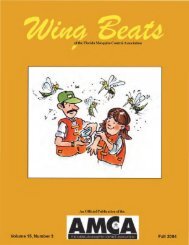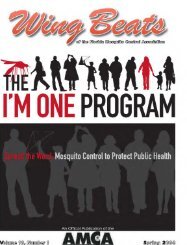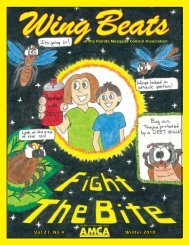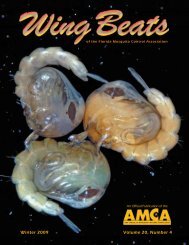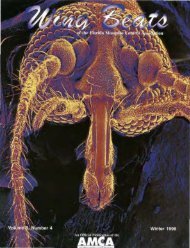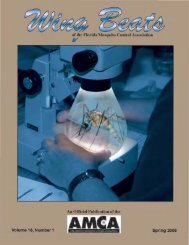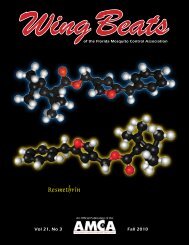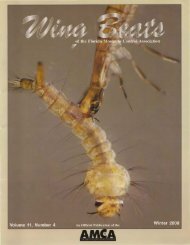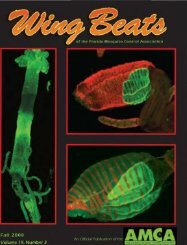ofthe Florida Mosquito Control Association - Wing Beats - Florida ...
ofthe Florida Mosquito Control Association - Wing Beats - Florida ...
ofthe Florida Mosquito Control Association - Wing Beats - Florida ...
You also want an ePaper? Increase the reach of your titles
YUMPU automatically turns print PDFs into web optimized ePapers that Google loves.
, <strong>ofthe</strong> <strong>Florida</strong> <strong>Mosquito</strong> <strong>Control</strong> <strong>Association</strong><br />
An Official Publication <strong>ofthe</strong><br />
Volume 15, Number 2 Summer2004
Figure 2. Modified hand-held<br />
ULVunit<br />
switch from twisting, apply a<br />
dab of J.B. Weld. Grind the<br />
timer cover sufficiently to clear<br />
the lever on this switch (Figure<br />
1 ).<br />
Run the C0 2 through a regulator<br />
set at 15 psi th en through<br />
a Y4 inch hose hooked to the top<br />
of the timer. On the other end<br />
of the timer, use an in line filter<br />
and a 0.007 orifice available<br />
from Clark <strong>Mosquito</strong> <strong>Control</strong>.<br />
Add an ant screen to prevent<br />
ants from getting into the electronics<br />
(Figure 1 ).<br />
We have found that a 10<br />
lb C0 2 canister will last about<br />
21 hours. This reduces staff<br />
time for changing out canisters<br />
and saves money in both<br />
the cost of C0 2 and manhours.<br />
The internal 9-volt battery<br />
is replaced at the start of<br />
the season. The trap can be<br />
field tested to make sure it is<br />
in working order simply by<br />
pressing a button. A second<br />
press of the button and you<br />
can be confident that the trap<br />
will work.<br />
Preliminary experiments<br />
have been conducted<br />
with dual timers<br />
that allow monitoring of<br />
different species on the<br />
same night or monitoring<br />
on consecutive days.<br />
Field trials will be conducted<br />
over the summer.<br />
We plan to test this in<br />
evaluating the efficacy of<br />
spray missions.<br />
Note: MMS uses<br />
compressed C0 2 but<br />
one can also use dry ice<br />
in an insulated container,<br />
such as an ammunition container<br />
available from military<br />
surplus, with a tight seal and<br />
locking top. Run a hose from the<br />
top of the container to the top<br />
of the timer and hook the rest<br />
of the equipment up in the same<br />
manner as described above.<br />
This should save some evaporation<br />
of the dry ice and only<br />
expel C0 2 at set times, although<br />
the flow rate will not be as consistent<br />
as that with compressed<br />
C0 2 •<br />
Air must flow around and<br />
through the nozzle.<br />
Modified backpack unit<br />
Hand-Held ULV Unit<br />
By modifying a hand-held<br />
gasoline powered blower a less<br />
expensive and more efficient<br />
ULV spray un it can be made.<br />
We use a BG85 hand-held Stihl<br />
because it has proven to be reliable<br />
and because it is easy to<br />
acquire replacement parts. The<br />
completed unit costs about<br />
$300. It is lighter than anything<br />
on the market and quieter with<br />
a decibel range of 70 at idle<br />
speed, just 10 decibels above<br />
normal speech. The unit<br />
weighs only 8.8 lbs. and has<br />
an air flow velocity of 183<br />
mph. The velocity has the advantage<br />
of moving the foliage,<br />
forcing the mosquitoes to<br />
break cover and fly into the<br />
spray. These units cover an<br />
area of 15 to 20 feet compared<br />
to the 4 to 5 feet of<br />
most hand-helds, reducing the<br />
time needed to effectively<br />
treat an area.<br />
The nozzle is taken from a<br />
Curtis Dyna-Fog Twister (Part<br />
#62313) with a cost of approximately<br />
$55. Care must<br />
be taken that the air flows<br />
16''"9 r?e
around as well as through the<br />
nozzle (Figure 2).<br />
Tap the nozzle holding holes<br />
for a #8/32 screw. Use long<br />
screws with backup nuts to hold<br />
the nozzle in place and centered.<br />
Remove the dispensing tip from<br />
a 16 oz. unitary wash bottle<br />
(Consolidated Plastics, part<br />
#40015LU 800) and attach a 3/<br />
16-inch chemical hose. Notch<br />
the top of the bottle to let it vent.<br />
Use a standard inline fuel filter<br />
and an orifice from Curtis<br />
Dyna-Fog (Use part 64933-19<br />
or 64933-28 or 64933-36, which<br />
equal orifice sizes 19, 28 and<br />
36 respectively).<br />
If necessary, number drills<br />
can enlarge the holes to meet<br />
your needs. Use a standard %<br />
turn gas valve and hook it to the<br />
nozzle. Keep the turn-off valve<br />
as close as possible to the<br />
nozzle to minimize the possibility<br />
of leaks.<br />
One Backpack Unit<br />
for Larvicide and ULV<br />
For backpack sprayers we<br />
use Maruyama backpacks from<br />
ADAPCO, Stihl and Echo. They<br />
have a 2-inch tube, so use a 2inch<br />
to 3-inch rubber pipe reducer<br />
from a plumbing supply<br />
store. If the backpack has a 3inch<br />
tube just mount the nozzle<br />
in the tube. It is important to<br />
mount the nozzle in a 3-inch tube<br />
for any backpack because of<br />
the extra volume of air backpack<br />
blowers produce.<br />
With any backpack unit an extra<br />
tube can be purchased and<br />
the unit can be set up for<br />
adulticiding and ULV. With a<br />
simple twist of the tube, the<br />
same unit goes from dry chemi-<br />
6 Summer 2004<br />
cal to liquid. Do not turn on the<br />
larvicide with the ULV nozzle<br />
hooked up. The pellets jam up<br />
the nozzle and they are hard to<br />
clean out.<br />
For questions or comments<br />
contact Art Hodous at 941-861-<br />
9760 or ahodous@scgov.net<br />
Sources for Parts<br />
ADAPCO, 2800 S Financial<br />
Ct., Sanford, FL 32773 (800)<br />
367-0659<br />
Clark Environmental Services,<br />
P.O. Box 72197 159 Garden<br />
Ave. Roselle, IL 60172<br />
(800) 443-2034<br />
Consolidated Plastics Company<br />
Inc., 8181 Darrow Rd.<br />
Twinsburg, OH 44087<br />
(800) 362-1000<br />
Curtis Dyna-Fog, P.O. Box<br />
297 17335 US 31N, Westfield,<br />
IN 4607 4-0297<br />
(317) 896 2561<br />
DIG Irrigation Products,<br />
1210 Activity Drive, Vista, CA<br />
92081 (800) 322-9146<br />
Echo Inc., 400 Oakwood Rd.,<br />
Lake Zurich, IL 60047 (800)<br />
673-1558<br />
Stihl Inc., 536 Viking Drive,<br />
Virginia Beach, VA 23452<br />
ArtHodus<br />
Fabrication Specialist<br />
and<br />
Laurie Tarleton<br />
Program Assistant/ Outreach<br />
Sarasota <strong>Mosquito</strong><br />
Management Services<br />
Sarasota, FL<br />
From the Editor-in-Chief<br />
We are looking for interesting technical or fieldrelated<br />
articles about mosquitoes, mosquito<br />
control, and related topics. The articles do not<br />
have to be "scientific" in nature and not too<br />
long - usually two or three pages (1 000 to 2000<br />
words). Pictures will really enhance your<br />
article.<br />
Forward articles to:<br />
Marin Brouillard<br />
Collier <strong>Mosquito</strong> <strong>Control</strong> District<br />
600 North Road<br />
Naples, FL 34104<br />
Phone: (239) 436-1000<br />
Fax: (239) 436-1005<br />
email: wingbeats@collier-mosquito.org<br />
Go to<br />
www.floridamosquito.org<br />
and check out the new<br />
FMCA web site.<br />
It looks great!<br />
Thanks to Tom Floore,<br />
webmaster, for all of his<br />
hard work.
The mosquito control community and the Pasco <strong>Mosquito</strong><br />
<strong>Control</strong> District suffered a great loss with the passing<br />
of their recently retired director, Jim Robinson on<br />
April11 1 h, 2004.<br />
On March 12,2004, over 150 individuals attended a<br />
luncheon for Jim<br />
Robinson as he retired<br />
from the Pasco County<br />
<strong>Mosquito</strong> <strong>Control</strong> District<br />
(PCMCD) after having<br />
served as its Director for<br />
the past 30 years. The<br />
luncheon, which was provided<br />
by PCMCD, was<br />
held in beautiful weather<br />
at the District office.<br />
Newly appointed Director<br />
Dennis Moore was the<br />
Master of Ceremonies for<br />
this gala event, which<br />
served as a fitting opportunity<br />
for Jim's family,<br />
friends and many colleagues<br />
to recognize his<br />
creative accomplishments<br />
in our industry and<br />
to wish him well in retirement.<br />
Several heartfelt<br />
presentations were made<br />
by Jim's Commissioners<br />
(Chairman Rosemary<br />
Mastrocola, Sandra<br />
Applefield, with Charlie<br />
Brown in attendance}, his<br />
wife Mary Anne, and colleagues<br />
(including Frank<br />
Evans, Bill Opp, John<br />
Beidler, Joe Ruff and<br />
David Dame).<br />
Jim grew up on a farm<br />
in Huntingdon, Pennsylvania. He attended Juniata College<br />
and received a bachelor of science degree with a<br />
double major (physics and biology) and later earned his<br />
master's degree in entomology at Rutgers University<br />
where his thesis involved the study of tabanids on the<br />
New Jersey salt marshes. Directly after graduation from<br />
Rutgers, Jim was hired as an entomologist by the Pasco<br />
County <strong>Mosquito</strong> <strong>Control</strong> District in <strong>Florida</strong> in August<br />
10 Sunnner2004<br />
1971. Within a year, Jim became the Assistant Director<br />
and in 197 4 was promoted to Director and served in<br />
that position for 30 years.<br />
Jim was known throughout the mosquito control industry<br />
as a true innovator, who made significant advances<br />
in our discipline.<br />
During his tenure, Jim developed<br />
one of the finest<br />
and most highly-respected<br />
mosquito control programs<br />
in the world. His office frequently<br />
invented or initiated<br />
some of the most advanced<br />
control techniques, many of<br />
which have become industry<br />
standards. Jim was a<br />
major catalyst in developing<br />
the "High Pressure Application<br />
System" that is<br />
revolutionizing the aerial<br />
application industry in mosquito<br />
control. This system<br />
reduces the amount of insecticide<br />
necessary for<br />
adult mosquito control,<br />
which reduces the cost of<br />
treatment and minimizes<br />
the potential for undesirable<br />
environmental effects.<br />
Jim has been recognized at<br />
the national and world level<br />
for his years of service to<br />
such a worthwhile cause.<br />
In November 2003, at<br />
the <strong>Florida</strong> <strong>Mosquito</strong> <strong>Control</strong><br />
<strong>Association</strong>'s (FMCA)<br />
annual meeting in Miami,<br />
the FMCA presented Jim<br />
with the Maurice W. Provost<br />
Award, having previously<br />
honored him with the Fred Stutz Memorial Award<br />
(the FMCA's highest award for operational achievements)<br />
in 1996. In February of 2004, the American <strong>Mosquito</strong><br />
<strong>Control</strong> <strong>Association</strong> awarded Jim the Meritorious<br />
Service Award during its annual meeting in Savannah.<br />
They had previously honored him with a Presidential<br />
Citation. All are fitting recognitions for Jim Robinson,<br />
who was a true gentlemen and a leader in our field.
RECOGNIZE THE INDIVIDUALS WHO HAVE MADE OUTSTANDING<br />
CONTRIBUTIONS TO MOSQUITO CONTROL:<br />
NOMINATE THEM FOR The 2004 AMCA Awards!<br />
Any <strong>Florida</strong> <strong>Mosquito</strong> <strong>Control</strong> <strong>Association</strong> member in good standing may nominate a candidate for any award by submitting<br />
supporting information to the Awards Committee, to include a short biographical sketch of the nominee, emphasizing those<br />
accomplishments deemed worthy of the award. There is no official nomination form. Endorsements and written support from<br />
other colleagues are encouraged.<br />
All submissions will be acknowledged. Nominations must be received by August 6, 2004.<br />
The Maurice W Provost Memorial Award, established as a memorial to the first director of the <strong>Florida</strong><br />
Medical Entomology Laboratory, honors persons who have made outstanding contributions to mosquito control<br />
and/or biting fly biology in <strong>Florida</strong>. Recipients have been instrumental in developing sound management and<br />
operational methods to reduce pesticide levels and to minimize habitat alteration while reducing mosquito populations;<br />
in increasing our knowledge of mosquitoes and other biting insects and their habitats; and in educating<br />
students and the general public about the importance of various environmental issues facing the citizens in protecting<br />
the fauna and flora in <strong>Florida</strong>.<br />
The Joseph Y Porter Distinguished Achievement Award recognizes the first president of the <strong>Florida</strong><br />
Anti-<strong>Mosquito</strong> <strong>Association</strong> and first State health officer of <strong>Florida</strong>, and recognizes scientists who have made significant<br />
contributions to entomology, with special emphasis on the abatement of arthropods of public health importance.<br />
The recipient must have meritoriously contributed to the advancement of entomology research in the field of<br />
mosquito and other biting arthropod control in the State of <strong>Florida</strong>.<br />
The Fred Stutz Memorial Award honors the former director of Dade County <strong>Mosquito</strong> <strong>Control</strong>, and was<br />
intended to recognize an outstanding contribution to mosquito control by development of procedures that increase<br />
effectiveness in mosquito and other arthropod control, or the design and manufacture of equipment that helped<br />
revolutionize the control of mosquitoes and other arthropods of public health importance. Supporting information<br />
should also include an evaluation and appraisal of the nominee’s accomplishments.<br />
The Sherrie Yarberry Award was named for a dedicated employee of Jacksonville <strong>Mosquito</strong> <strong>Control</strong>, and<br />
was intended to recognize continued outstanding contributions to operational program activities by veteran, nonadministrative<br />
personnel of <strong>Florida</strong> mosquito control related agencies. The recipient must demonstrate exemplary<br />
performance resulting in enhanced unit efficiency or public recognition of excellence of the parent organization.<br />
Supporting information from senior mosquito control administrators and supervisors should include an evaluation<br />
and appraisal of the nominee’s accomplishments.<br />
The FMCA Merit Award is intended to recognize the outstanding individual contribution to promoting control of<br />
disease-transmitting and pestiferous mosquitoes or other arthropods of public health importance, for scientific<br />
advancement of the discipline, or for developing or extending the public interest in the control of such mosquitoes or<br />
other arthropods. The recipient should represent those characteristics generally associated with responsible leadership,<br />
good citizenship and personal integrity. The recipient need not be a member of the <strong>Association</strong>.<br />
Please submit all inquiries and nomination documents to: Stephen L Sickerman<br />
DACS Bureau of Entomology & Pest <strong>Control</strong>, 3920 Frankford Avenue, Panama City, FL 32405-1953<br />
phone 850-872-4250 fax 850-872-4271 e-mail sickers@doacs.state.fl.us<br />
16 Summer 2004 <strong>Wing</strong> <strong>Beats</strong>
In 1988, the AMCA held the<br />
first student paper symposium<br />
at the annual meeting to focus<br />
on the contributions of AMCA<br />
student members. The Board<br />
of Directors approved the first<br />
student paper competition for<br />
the 1989 meeting in Boston,<br />
Massachusetts. The competition<br />
has been a recurring symposium<br />
during the AMCA Annual<br />
Meeting. Dr. Roger Nasci<br />
was the organizer and moderator<br />
from the first competition in<br />
1989 until 2002. Dr. Roxanne<br />
Rutledge-Connelly is currently<br />
the competition organizer and<br />
moderator.<br />
The AMCA Board of Directors<br />
accepted a motion in 1997<br />
to designate the first place winner<br />
of the AMCA student paper<br />
competition as the winner<br />
of the "Hollandsworth Prize".<br />
This prize includes a $500.00<br />
cash award and a plaque from<br />
the AMCA. Two honorable<br />
mention prizes of $250.00 each<br />
are available to award at the discretion<br />
of the judges for each competition.<br />
In 2003, theAMCABoard<br />
of Directors voted to increase the<br />
prize money for the winner of the<br />
competition and added $500.00 to<br />
the total cash award that the<br />
Hollandsworth Prize winner receives<br />
bringing that prize to<br />
$1000.00.<br />
The Hollandsworth Prize is<br />
named in honor of Gerald<br />
Hollandsworth, a former AMCA<br />
member from Pueblo, Colorado,<br />
who passed away in 1988. Gerald<br />
18 Summer 2004<br />
Greg Williams<br />
Gerald Hollandsworth<br />
worked in Environmental<br />
Health with the Pueblo City<br />
County Health Department.<br />
He was a past president of the<br />
West Central <strong>Mosquito</strong> and<br />
Vector <strong>Control</strong> <strong>Association</strong>.<br />
The Hollandsworth family<br />
generously provide for this<br />
award to encourage student<br />
participation in the AMCA national<br />
meeting.<br />
The 15 1 h AMCA Student<br />
Paper competition was held in<br />
2004 during the AMCA's 70 1 h<br />
Annual Meeting in Savannah,<br />
Georgia. There were 9 student<br />
participants representing<br />
7 institutions. The judges who<br />
volunteered their time for a<br />
half day this year were Dr.<br />
Mark Blackmore of Valdosta<br />
State University, Valdosta,<br />
Georgia; Dr. Ralph Harbach<br />
from the Natural History Museum,<br />
London, UK; and Dr.<br />
Don Shroyer from the Indian<br />
River <strong>Mosquito</strong> <strong>Control</strong> District,<br />
Vero Beach, <strong>Florida</strong>.<br />
The winner of the<br />
Hollandsworth Prize was Gregory<br />
Williams from the University of<br />
Delaware who presented research<br />
on "Prevalence of West Nile virus<br />
in crowvs. non-crow areas". Greg<br />
is from Cranford, New Jersey and<br />
received his BA. from Rutgers in<br />
1997 and a M.S. from North Carolina<br />
State University in 2002. He<br />
was introduced to the field of entomology<br />
by Dr. Wayne Crans at<br />
Rutgers, has worked in pest control<br />
and he conducted his Master's<br />
research on IPM of German cock-
oaches in schools. He is currently<br />
working on a Ph.D. in the University<br />
of Delaware's Department of<br />
Entomology with co-advisors Dr.<br />
Jack Gingrich and Dr. Charles Mason.<br />
Greg is the Entomology<br />
Department's student representative<br />
to the Entomological Society<br />
of America and he anticipates<br />
graduating in Spring of 2005.<br />
Two honorable mentions were<br />
awarded; the recipients were<br />
Stephen Aspen of Colorado State<br />
University and Christian Kaufmann<br />
of the University of Zurich. Mr.<br />
Aspen's paper was, "Nucleotide<br />
sequences in the acetylcholinesterase<br />
gene Ace.2 distinguish<br />
among members of the Culex<br />
pipiens Complex." Mr. Kaufmann<br />
presented "Flight potential and<br />
metabolism of Anopheline mosquitoes."<br />
2004 AMCA Student Competition participants.<br />
It is through the commitment of<br />
the Hollandsworth family, the<br />
AMCA, and the judges who volunteer<br />
their time that the AMCA is<br />
able to continue the competition<br />
and encourage students to be involved<br />
in the <strong>Association</strong>. Students<br />
are the future of the AMCA<br />
and it is important to continue to<br />
recognize and support our students<br />
early in their careers.<br />
Congratulations to all <strong>ofthe</strong> winners<br />
and thanks to all of the student<br />
participants for an excellent<br />
round of presentations this year!<br />
Students may enter the competition<br />
each year they are in school;<br />
previous winners may enter again.<br />
It is not too early to start thinking<br />
about possible research topics to<br />
present at the 2005 annual meeting<br />
in Vancouver.<br />
For information on the guidelines<br />
for participants and the call<br />
for papers for 2005, please visit<br />
the AMCA website<br />
www.mosquito.org and look under<br />
the pull-down menu on the left side<br />
of the page called "<strong>Association</strong>";<br />
there is a new section there titled<br />
"Students" where the guidelines<br />
will be posted when the<br />
2005 call for papers is issued.<br />
,.<br />
Roxanne Rutledge-Connelly, PhD<br />
Assistant Professor,<br />
Extension Medical Entomologist<br />
University of <strong>Florida</strong><br />
<strong>Florida</strong> Medical<br />
Entomology Laboratory<br />
16''"9 i$'eaU. Summer 2004 19
Introducing a new_wave<br />
for environmental science.
An Unfortunate Hyperbole<br />
that wodt go Away<br />
"Without mosquitoes, bats would have no food." ..... speaker at a recent mosquito control meeting.<br />
"A small fleeting<br />
shadow darts across my<br />
path at deep dusk, just<br />
before complete darkness<br />
forbids safe steps in<br />
the marsh. <strong>Mosquito</strong>es<br />
have discovered my trail<br />
of C02, examined my<br />
skin covered with repellent,<br />
and are hovering<br />
close by ..... waiting. Another<br />
shadow, now nearly<br />
impossible to distinguish<br />
from the darkness, darts<br />
a backslash path in front<br />
of me. Two bats are foraging<br />
on the evening<br />
prey.<br />
<strong>Mosquito</strong>es are hovering in C02<br />
plumes. The bats are not close<br />
enough to me to consume the hovering<br />
mosquitoes, so are there<br />
many more mosquitoes in clouds<br />
all around me? Can the bat distinguish<br />
me from a tree trunk, a shrub<br />
or a 4-wheeler? Bats do not sense<br />
Moon flower<br />
22 Sununer2004<br />
<strong>Mosquito</strong>es hatching<br />
C02 plumes. A moth suddenly appears<br />
in the garden next to the<br />
marsh, to sip nectar from 3 inch<br />
wide moonflowers beaming white<br />
in the darkness. Another dart of<br />
darkness slashes near the moonflower<br />
and the beaming white<br />
flower goes on un-pollinated.<br />
I love to walk near the marsh<br />
behind the garden to hear the frog<br />
cacophony and to soak in the<br />
<strong>Mosquito</strong> burdened cats<br />
softly humid evening air,<br />
filled with summer fragrance.<br />
Sometimes, after a<br />
long, dry spell, dust covers<br />
the faded leaves, and<br />
they are finally washed<br />
clean by a long, light<br />
shower. It is warm enough<br />
to stay in the garden even<br />
though it is raining. Two<br />
inches of rain falls and finally<br />
fills the marsh edges<br />
by the next morning. Insects<br />
and frogs waiting in<br />
the muddy soil emerge.<br />
The frogs are exuberant!<br />
Songs are everywhere.<br />
My next walk by the marsh<br />
brings a new generation of mosquitoes<br />
exploding from the water<br />
and rushing to explore the chemicals<br />
in the air for the first time.<br />
There are too many mosquitoes<br />
now for the repellent to work be-<br />
<strong>Mosquito</strong> landscape
cause hundreds of tiny feet have<br />
stepped on my arms and neck and<br />
carried it away. It is a good night<br />
for feeding. Small flies have<br />
emerged from the flooded soil,<br />
and moonflowers beam to them<br />
and to the moth feeders. It is summer<br />
rush hour in the garden.<br />
Bat shadows are seen once or<br />
twice in the evening as before.<br />
Bats feed singly after communal<br />
roosting and after frightening flights<br />
from the roost. A feast of mosquitoes<br />
emerged and the bat roost<br />
did not plan a banquet. Lone diners<br />
carefully choose the largest<br />
radar target for a main course.<br />
Hor'doerves are occasionally<br />
taken, but not at the risk of flying<br />
too close to a tree trunk, bush, or<br />
4-wheeler.<br />
From inside the screen porch<br />
now, I see the green treefrogs<br />
gathering on the wall by the outdoor<br />
lights. They snap up insects<br />
drawn to the light also. Moths,<br />
craneflies, and other small insects<br />
disappear in an instant when a<br />
sluggish but fast-tongued frog is a<br />
sentinel.<br />
Larvae with pigmented spines<br />
Some mosquitoes have followed<br />
me inside the porch, and<br />
others, trapped inside or emerged<br />
from indoor flowerpot saucers are<br />
nipping at my ankles. The bats do<br />
not come inside.<br />
A bat or two briefly breaks the<br />
last glimmer of dusk in the western<br />
sky. I try to carefully open the<br />
sliding glass door to the dining<br />
room so that mosquitoes won't fly<br />
in with me. As I quickly open the<br />
door I am met by a "Yeooow". The<br />
Hummingbird moth<br />
cat wants to get out.again to brush<br />
them off her, and more fly in.<br />
The bats are gone or invisible<br />
against the dark sky. The moon is<br />
only a crescent, and only the tall<br />
fringe at the top of the pine tree<br />
line can be seen against the starlit<br />
sky.<br />
There are at least five mosquitoes<br />
in the house, with two people<br />
and two cats. The mosquitoes are<br />
where the C02 is, and the bats are<br />
full, or flying and beaming for another<br />
decent meal.<br />
Ecological balance in an r-selected<br />
reproductive cycle is a longterm<br />
operation. Both predator and<br />
prey banquet times seldom match.<br />
There are time lags and often<br />
predator or prey population<br />
crashes. Rain falls at different<br />
times every year. Communication<br />
seems non-existent. It reminds<br />
me of government budget-making.<br />
Planning for emergencies is only<br />
a skeleton of ideas because the<br />
memory of a great need for workers<br />
is fleeting.<br />
The bat roost remains the<br />
same, unless the cave or bridge<br />
is destroyed. There is no predict-<br />
continued on page 32<br />
11/"'9 iS'e4U Summer 2004 23
•RAMP<br />
West Nile Virus Test<br />
High Sensitivity Vector Screenin g Technology<br />
> 80% in Comparison to PCR<br />
> 95% Correlation to EUSA<br />
At least 100 times more sensitive<br />
than existing rapid test<br />
Removes Subjective Visual Results<br />
Allows Quick Eradication of Positive Pools<br />
Other Arbovirus Tests in Development:<br />
• Eastern Equine Encephalitis<br />
• Westem Equine Encephalitis<br />
• St. LOUIS Encephalitis<br />
800-367-0659<br />
e-adapco.com
For those who attended and participated in the raffle during the<br />
AMCA annual meeting in Savannah this year, in an effort to<br />
assist Mickey Marshall and family after their motorcyle<br />
accident, thank you!<br />
From the Marshall’s:<br />
“Thank you to everyone that has contributed through donations, emails,<br />
prayers, thoughts, and visits. Our family has been amazed at the support<br />
we received from Mickey’s ‘extended’ family at ADAPCO and beyond to<br />
customers, vendors, and others. Our appreciation and gratitude extends<br />
to everyone.” Michelle Marshall<br />
The raffle results are as follows:<br />
Raffle 1: Browning Shot-gun<br />
Rob Boyer<br />
Raffle 2: 3 - day, 2 - night Best Western Disney Orlando<br />
Dave Brown<br />
Raffle 3: 2 annual passes to Universal Studios Orlando<br />
Steve Nawrocki<br />
SOUTHWEST ASSURANCE CORP OF FL / AMMIA<br />
THE PREFERRED INSURANCE PROGRAM<br />
HOW MUNICIPALITIES AND TAXING DISTRICTS CONTAIN THE HIGH COST OF INSURANCE PROTECTION<br />
GENERAL LIABILITY *** PROFESSIONAL LIABILITY *** AUTOMOBILE LIABILITY<br />
AVIATION LIABILITY *** AVIATION HULL *** AVIATION CHEMICAL LIABILITY<br />
SOUTHWEST ASSURANCE CORPORATION OF FL (PROGRAM ADMINISTRATORS)<br />
401 EAST JACKSON STREET, SUITE 1700 TAMPA, FLORIDA, 33602<br />
PHONE: 800-527-4953 FAX: 813-222-4040<br />
AMCA, Sustaining Member<br />
<strong>Wing</strong> <strong>Beats</strong><br />
Summer 2004<br />
25
From where I sit. .... Slated for May<br />
3-5 at the Crystal City Hilton in Arlington,<br />
Virginia, the AMCA 6 1 h Annual<br />
Spring Washington Conference will<br />
have been completed by the time you<br />
read this. Hopefully, a good many of<br />
you will have attended this important<br />
event and have returned to your districts<br />
knowing that you've done your part<br />
to educate our legislators in the various<br />
issues critical to our profession.<br />
To those who did not attend, allow me<br />
to brief you on the breadth of our festivities.<br />
Education is the hallmark of this<br />
conference. The learning curve of attendees<br />
in Capitol Hill visitation protocol<br />
in addition to specific issues is<br />
steep, but facilitated by an enormous<br />
amount of legwork done beforehand by<br />
various association members affiliated<br />
with the AMCA Legislative & Regulatory<br />
Committee. Bill Meredith, in particular,<br />
has invested a great deal of time<br />
and effort developing a conference<br />
agenda that provides attendees succinct<br />
background information on issues and<br />
methods of successfully communicating<br />
these issues to our legislators. Dr.<br />
Meredith and the other meeting organizers<br />
have gone to great lengths to<br />
ensure that attendees feel comfortable<br />
with their knowledge of the issues and<br />
their ability to convey our concerns to<br />
members of Congress.<br />
Conference speakers are chosen<br />
from the legislative branch and various<br />
government agencies based upon their<br />
intimate knowledge of issues affecting<br />
mosquito control. Indeed, many of the<br />
speakers are the actual decision makers<br />
in the process. Obtaining their views<br />
firsthand is invaluable. Speakers this<br />
year included:<br />
•JIM JONES (EPA/OPP): Views from<br />
the Director of EPA's Office of Pesticide<br />
Programs on issues of concern<br />
to Vector <strong>Control</strong>.<br />
26 Summer 2004<br />
From Where I Sit:<br />
Notes From the AMCA<br />
Technical Advisor<br />
•ADAM SHARP (EPA): Clean Water<br />
Act!NPDES Permit Issues Relative to<br />
<strong>Mosquito</strong> <strong>Control</strong>.<br />
•ARTHUR-JEAN W ILLIAMS (EPA/<br />
OPP/FEAD): Endangered Species Act<br />
and <strong>Mosquito</strong> <strong>Control</strong><br />
•JIM ROELOFS ( EPA/OPP):<br />
<strong>Mosquito</strong>cide Label-Language Issues.<br />
•ANNE CANNON (Legislative Director<br />
to Dennis Cardoza (R-CA): <strong>Mosquito</strong><br />
<strong>Control</strong> Perspectives<br />
·TOM STEWART (USFWS, Division of<br />
Natural Resources): <strong>Mosquito</strong> <strong>Control</strong><br />
on National Wildlife Refuges<br />
•SHANNON SHANTZ (Director, Gem<br />
County MAD, Idaho): NPDES Permit<br />
Issues in Gem County, Idaho Threatens<br />
<strong>Mosquito</strong> <strong>Control</strong> Operations<br />
A new and particularly interesting<br />
feature this year was obtaining the services<br />
of Jay Feldman, Executive Director<br />
of the Beyond Pesticides/National<br />
Campaign Against the Misuse of Pesticides<br />
advocacy group for a special session<br />
entitled "To Spray or Not to Spray".<br />
Mr. Feldman is an articulate and ardent<br />
activist who takes issue with a<br />
great deal of our profession's activities,<br />
but does so without the rancor<br />
usually associated with activists. It's certainly<br />
to his credit that he agreed to<br />
address our assemblage.<br />
This conference is primarily convened<br />
to discuss and communicate issues<br />
of interest to our profession to legislators<br />
who are in a position to act upon<br />
them. This is accomplished through provision<br />
of issue Point Papers to the attendees.<br />
These Point Papers are one<br />
page in length and describe the issue,<br />
provide background, discuss its implications,<br />
and recommends a plan of action<br />
for the legislator. Point Papers are<br />
drafted by AMCA members considered<br />
experts in the particular issue and undergo<br />
several reviews and iterations<br />
prior to final disposition. When com-<br />
pleted, they are placed in a packet that<br />
is taken to Capitol Hill and presented to<br />
legislators for their reference after discussion<br />
of several of the topics within.<br />
The Point Paper topics for this year's<br />
conference are listed below in no particular<br />
order of importance:<br />
1. Stormwater Management<br />
Facilities and <strong>Mosquito</strong><br />
Product ion<br />
1) Regulations issued under the<br />
1987 amendments to the Clean Water<br />
Act (CWA) require that pollution associated<br />
w ith stormwater be reduced<br />
through the use of "Best Management<br />
Practices," (BMP) many of which lead<br />
to significant production of mosquitoes,<br />
rats, and other vectors; and potentially<br />
to substantial public health impacts. 2)<br />
The U.S. Environmental Protection<br />
Agency (EPA), which has issued the<br />
regulations, has essentially ignored<br />
public health risks associated with vectors<br />
in their regulations and guidance<br />
documents, leading uninformed permit<br />
holders to create new health threats and<br />
public nuisances, and trapping local<br />
governments between conflicting requirements.<br />
3) Regulations or opinions<br />
issued by U.S. Fish and Wildlife Service<br />
(USFWS) for protection of endangered<br />
species frequently prohibit or<br />
sharply limit vector control activities or<br />
the maintenance activities which might<br />
prevent vector production in some<br />
stormwater facilities.<br />
2. Endangered Species Act Consid·<br />
erations and<br />
<strong>Mosquito</strong> <strong>Control</strong><br />
Implementation of EPA Risk Assessments<br />
in fulfilling Endangered Species<br />
Act mandates must fully consider mosquito<br />
control and public health impacts.<br />
3. Funding the <strong>Mosquito</strong> Abatement<br />
for Safety and Health A ct Public<br />
Law108-75<br />
Federal funds should be appropriated<br />
for the enactment of Public Law
108-75, the <strong>Mosquito</strong> Abatement for<br />
Safety and Health Act (MASH).<br />
4. A "Pesticides in Schools"<br />
Act -Impacts to <strong>Mosquito</strong> <strong>Control</strong><br />
The notification process mandated<br />
by the proposed Congressional Bill H.R.<br />
121 , known as the "School Environmental<br />
Act of 2003" introduced in the P 1<br />
session of the 1 081h Congress, could<br />
greatly compromise mosquito control<br />
operations on or near school grounds.<br />
5. Clean Water Act Provisions and<br />
<strong>Mosquito</strong> <strong>Control</strong><br />
The term "pollutant", as defined by<br />
the Clean Water Act (CWA) and interpreted<br />
by EPA as enforcing authority,<br />
should not include the application of pesticides<br />
for beneficial purposes such as<br />
mosquito control, when made in accordance<br />
w ith their labeling as approved<br />
by EPA under the Federal Insecticide,<br />
Fungicide, and Rodenticide Act<br />
(FIFRA).<br />
6. FEMA, <strong>Mosquito</strong>-borne Diseases,<br />
and Emergency <strong>Mosquito</strong> <strong>Control</strong><br />
Flooding caused by hurricanes,<br />
broken dams, or other factors may result<br />
in the production of mosquitoes that<br />
transmit disease or occur in numbers<br />
so great that recovery work is hampered.<br />
Disasters may also damage or<br />
destroy homes, exposing inhabitants to<br />
mosquitoes to a greater extent than normal.<br />
<strong>Control</strong> of mosquitoes in these<br />
scenarios is vital if people are to be<br />
protected against the diseases and<br />
hardships caused by mosquitoes. The<br />
Federal Emergency Management<br />
Agency (FEMA), through its disaster<br />
recovery activities and funding assistance,<br />
has a responsibility to aid in the<br />
control of mosquitoes after disasters,<br />
but has been inconsistent and unpredictable<br />
in its approach to mosquito<br />
control after disasters. This has caused<br />
confusion to those w ho need this assistance<br />
and to those agencies providing<br />
it.<br />
7. Label Language for EPA-Registered<br />
<strong>Mosquito</strong>cides<br />
Confusing or contradictory language<br />
on product labels for mosquito<br />
control insecticides often creates unwarranted<br />
concerns for the public, and<br />
public relations problems for mosquito<br />
control practitioners.<br />
8. <strong>Mosquito</strong> <strong>Control</strong> on<br />
National Wildlife Refuges<br />
As a matter of agency policy and<br />
operational practice, effective and practicable<br />
mosquito control must be permitted<br />
on National W ildlife Refuges<br />
wherever Refuge-produced mosquitoes<br />
cause significant public health problems<br />
for people in off-Refuge areas.<br />
9. Need for Public Health Pesticide<br />
Data Collection<br />
Funding provisions of the Food<br />
Quality Protection Act (FQPA) for public<br />
health pesticide data collection have<br />
not been implemented by the Department<br />
of Health and Human Services<br />
(DHHS), where such data are critical<br />
for the registration and continued use<br />
of mosquito control insecticides.<br />
As you can see, there was much<br />
to discuss. The congressional visits are<br />
generally twenty or so minutes in length,<br />
so issues must be prioritized so that<br />
only two or three are addressed. This<br />
is generally left up to the visiting team<br />
leader and usually reflects the political<br />
and demographic realities w ithin the<br />
legislator's particular district. To ensure<br />
that congressional visitors are comfortable<br />
in their roles, state organizers assign<br />
visitors to teams headed by AMCA<br />
members who have organized and conducted<br />
congressional visits in the past.<br />
These team leaders are charged w ith<br />
coordinating the visits with the congressional<br />
schedulers and leading the issue<br />
discussions. There are times when<br />
the team actually meets with the legislator,<br />
but more often the team meets<br />
with a congressional aide who advises<br />
the legislator on the issues in question.<br />
But all was not work, either. One of<br />
the perennial highlights of the conference<br />
is the Dinner Reception, which is<br />
held from 5:30-8:00 pm after our congressional<br />
visits on Tuesday. The venue,<br />
in the House Agriculture Committee<br />
Conference Room in the Longworth<br />
House Office Building, offers a spectacular<br />
view of the Capitol Building. The<br />
reception consists of a superb BBQ<br />
Buffet, open bar and a chance to interact<br />
socially w ith peers, legislators and<br />
congressional aides. It's great fun and<br />
the food is exceptional.<br />
Over the years I have found these<br />
conferences to be extraordinarily informative<br />
and rewarding. This is our opportunity<br />
to affect the legislative process<br />
and shouldn't be missed. Critical<br />
to the success of this conference is attendance<br />
representing as many states<br />
as possible. It goes without saying that<br />
legislators are more likely to act upon<br />
issues presented by one of their ow n<br />
voting constituents. Thus, it is imperative<br />
that we ensure that key House and<br />
Senate committee members are visited<br />
by their own constituents. As you can<br />
well imagine, funding for attendance by<br />
the many AMCA members needed to<br />
visit key congressional staff is woefully<br />
short at the district or state level. Limited<br />
travel funding has been made available<br />
for this purpose.<br />
I sincerely hope that our footprint<br />
on Capitol Hill continues to grow as our<br />
members realize the importance of legislative<br />
advocacy. Our ability to ply our<br />
trade in a very real way depends upon<br />
an informed Congress. Please make<br />
plans to join us next year. Like me, you'll<br />
find the experience renews your faith<br />
in the mechanisms our representative<br />
government has in place to ensure that<br />
you are heard by our lawmakers.<br />
One of the functions of the<br />
AMCA is to represent the<br />
mosquito control point of view<br />
to government agencies and<br />
environmental organizations.<br />
Joe Conlon, the AMCA<br />
Technical Advisor, keeps us up<br />
to date on congressional and<br />
environmental actions related to<br />
mosquito control.<br />
16''"9 r?eaU Summer2004 27
"Unfortunate Hyperbole"<br />
continued from page 23<br />
ing when the weather will produce<br />
an emergency or a banquet.<br />
The bats fly out at<br />
night, and back to rest during<br />
the day. They eat alone.<br />
No backup bat youngsters to<br />
attend an occasional banquet.<br />
I once did a study of<br />
predator ground beetles,<br />
Ca/asoma frigidum, which<br />
suddenly appeared in great<br />
numbers during the th ird<br />
year of an outbreak of a<br />
defoliating moth<br />
Heterocampa guttivita. The<br />
moth larvae fed until they<br />
reached the end of a twig,<br />
and then dropped off to<br />
climb another tree and start<br />
on another twig . The<br />
beetles, which normally<br />
would be hiding in the mulch<br />
under the trees were rushing<br />
about, (then slowing down) eating<br />
as many larvae as they<br />
wanted. The following year<br />
there were far fewer moths and<br />
no beetles. The moth population<br />
was decreasing slowly, but<br />
the beetles had moved on. In<br />
many ecological relationships,<br />
sustained predator control of a<br />
pest is unpredictable and a huge<br />
gamble. When the forest is at<br />
risk, or in the case of mosqu<br />
itoes vectoring disease,<br />
when human health is at<br />
risk, human intervention<br />
may be the only choice.<br />
Since it is real istically<br />
very difficult to find a "pristine"<br />
untouched bit of landscape<br />
on the globe in this<br />
century (it usually makes<br />
the news if there is one) the<br />
idea of "natural balance" is<br />
becoming only a textbook<br />
myth. How long does a process<br />
have to continue in the<br />
32 Sununer2004<br />
Bats in the night sky<br />
same pattern to call it "balance"?<br />
What is the time frame<br />
of the cycle needed to reach<br />
"balance". Unfortunately human<br />
health risk cannot pause for<br />
even a two year cycle to reach<br />
a balance between predator and<br />
prey. "Balance" may never happen<br />
at all with a weather-responsive<br />
vector population.<br />
I think it is an unfortunate hyperbole<br />
when trained biologists<br />
Adult emergence<br />
simplify the complex system<br />
of community interaction as<br />
the speaker quoted at the<br />
beginning of this article did.<br />
statements like this, and others,<br />
are repeated, misinterpreted<br />
and can cause more<br />
conflict. The unmeasured,<br />
unavoidable, and inevitable<br />
intervention of humans in the<br />
environment is the "enemy".<br />
There are an entire series of<br />
statements on bat behavior<br />
which have been repeated in<br />
many forms. It seems to<br />
have started with a calculation<br />
of the energetic needs<br />
of a bat. Let's say, for example<br />
that in a single night a<br />
bat needs 12,000 calories,<br />
so another energetic calculation<br />
makes that 24,000<br />
mosqu itoes. What we then<br />
see on bat house sell ing<br />
websites is that a single bat can<br />
eat 24,000 mosquitoes per<br />
night! It could, but unless that<br />
bat flies through a gigantic hatch<br />
of salt marsh mosquitoes, it will<br />
not. Eventually, the local wisdom<br />
becomes: the bats will die<br />
if there are not mosquitoes<br />
emerging from every pond. Bat<br />
habitat, like most wild habitat is<br />
being lost, so bat populations<br />
are losing ground. Saving<br />
bats, however, does not<br />
have much, if any, relationsh<br />
ip to the population of<br />
mosquitoes. Insectivorous<br />
bats are useful as predators<br />
of insects, but like most<br />
predators, they sometimes<br />
take th ings we also like,<br />
such as a resting butterfly<br />
or a beautiful moth. Species<br />
conservation is also a<br />
much more complex picture<br />
than just one predator-prey<br />
interaction.
Out-of-this·<br />
Selection and<br />
orld<br />
•<br />
erv1ce.<br />
B&G is your one-stop source for. mosquito control<br />
supplies, equipment & repair services ...<br />
• Adulticides • Equipment • Seminars • Technical Support<br />
• Larvicides • Accessories • Repairs • Pest <strong>Control</strong> Supplies<br />
1·800·345·9387 bg hem.com
No one knew that 20 years after its inception,<br />
the training courses implemented from the idea<br />
of a brilliant and forward thinking man would still<br />
be one of the most highly sought after educational<br />
tools for most mosquito control programs.<br />
Glen Dodd's idea of "getting together" and talking<br />
about the issues of the day was discussed<br />
with the late Jim Robinson (former director of<br />
Pasco County <strong>Mosquito</strong> <strong>Control</strong> District in<br />
Odessa, FL), Bill Opp (director of Lee County<br />
<strong>Mosquito</strong> <strong>Control</strong> District in Ft. Myers, FL and<br />
AMCA President-Elect), John Beidler (former director<br />
of Indian River <strong>Mosquito</strong> <strong>Control</strong> District in<br />
Vero Beach, FL), and several of his numerous<br />
colleagues and friends.<br />
36 Sunnner2004<br />
For 10 of the 15 years that he was in mosquito<br />
control, Glen was the assistant director of the<br />
Indian River <strong>Mosquito</strong> <strong>Control</strong> District, in Vero<br />
Beach, FL. In 1984, Glen organized a "group<br />
discussion" in Vero Beach consisting of 6 courses:<br />
surveillance, larvicides, adulticides, application<br />
equipment, mosquito biology, and one of Glen's<br />
favorite topics- computers! Everyone sat around<br />
in a semicircle and "talked about things." What<br />
started as a simple idea has blossomed into one<br />
of the largest, and one of the best, sets of training<br />
courses for mosquito control.<br />
Initially, the courses were named the <strong>Florida</strong><br />
Anti-<strong>Mosquito</strong> <strong>Control</strong> <strong>Association</strong> (FAMA) training<br />
courses. In 1991 , FAMA was renamed the<br />
<strong>Florida</strong> <strong>Mosquito</strong> <strong>Control</strong><br />
<strong>Association</strong><br />
(FMCA) in order to align<br />
themselves with the<br />
American <strong>Mosquito</strong><br />
<strong>Control</strong> <strong>Association</strong><br />
(AMCA) and a more<br />
positive perception for<br />
the membership. After<br />
Glen Dodd's sudden<br />
and tragic death in<br />
1991 , and at the recommendation<br />
of Dr. Charlie<br />
Morris, the FMCA<br />
Board renamed the<br />
training courses for<br />
Glen.<br />
Since its inception,<br />
the Dodd Short<br />
Courses have evolved.<br />
The average attendance<br />
for Dodd is between<br />
350 and 400 students<br />
that travel from<br />
around the world. Stu-<br />
Or. Richard Darsie teaching at the Dodd Short Courses. dents have traveled<br />
from Washington, Cali-
38 Summer 2004 <strong>Wing</strong> <strong>Beats</strong><br />
Position Announcements<br />
<strong>Mosquito</strong> <strong>Control</strong> Biological Technician Position Available<br />
The Board of Commissioners of the Anastasia <strong>Mosquito</strong> <strong>Control</strong> District of St. Johns County<br />
is seeking applications for the position of Biological Technician. The applicant must have a<br />
minimum of a BS/BA Degree in Entomology, Zoology, Biology, or a closely related field.<br />
This position requires the applicant to have or obtain a current valid <strong>Florida</strong> driver’s license.<br />
Salary commensurate with applicant’s experience and ability. Mail, email or fax cover letter<br />
and resume to Anastasia <strong>Mosquito</strong> <strong>Control</strong> District of St. Johns County. Applications will be<br />
taken until position is filled.<br />
<strong>Mosquito</strong> <strong>Control</strong> Director Position Available<br />
The Board of Commissioners of the Anastasia <strong>Mosquito</strong> <strong>Control</strong> District of St. Johns County<br />
is seeking applications for the position of Director. The applicant must have a minimum of a<br />
Bachelor’s Degree in Entomology, Basic Sciences, Engineering, or a closely related field<br />
with a minimum of (7) years field operations experience and (3) years in a management<br />
position.<br />
The position requires the applicant to have, or be able to obtain, a Public Health Pest <strong>Control</strong><br />
Certification, Director’s Certification, and a current valid <strong>Florida</strong> driver’s license.<br />
Salary commensurate with applicant’s experience and ability. Mail, email or fax cover letter<br />
and resume to Anastasia <strong>Mosquito</strong> <strong>Control</strong> District of St. Johns County. Applications will be<br />
taken until position is filled.<br />
Anastasia <strong>Mosquito</strong> <strong>Control</strong> District of St. Johns County<br />
P.O. Box 1409<br />
500 Old Beach Road<br />
St. Augustine, FL 32085-1409<br />
Phone: 904 471-3107<br />
Fax : 904 471-3189<br />
Email: amcdsjc@bellsouth.net



